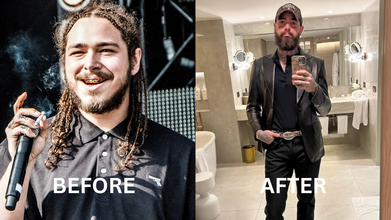- Health Conditions A-Z
- Health & Wellness
- Nutrition
- Fitness
- Health News
- Ayurveda
- Videos
- Medicine A-Z
- Parenting
After HIIT, Is Jeffing The New Go-To Cardio Workout?

Credits: Canva
For years, the definition for a "good" cardio session was simple- the more intense, the better. From sprinting to spinning classes, and lately, the HIIT workout, the fitness culture has always emphasized intensity over endurance. But a quiet revolution is brewing—one that's rewriting old notions about endurance, recovery, and performance. It's referred to as Jeffing, and it's nothing new—but its science-supported advantages are catching on with a fresh generation of runners, recreational athletes, and even endurance experts who want to train smarter, not harder.
Created by retired Olympian Jeff Galloway, Jeffing is a formal run-walk system intended to increase endurance, lower the threat of injury, and improve overall running performance. And yet, ironically, despite its effectiveness, the system is seen to feature prominently in marathon training programs, trail running, and even ultra-endurance events. As we redefine good cardio in an age more attentive to burnout and overtraining, Jeffing provides something revolutionary: permission to slow down—to go further.
So why is this hybrid strategy catching on now? And might Jeffing be the sustainable cardio solution that HIIT was never designed to be?
What Is Jeffing?
Named after American Olympian Jeff Galloway, Jeffing is a run-walk approach intended to make running easier, more enjoyable, and surprisingly, more efficient. Galloway, who ran in the 1972 Olympics and has a personal best of 28 minutes in the 10k, came up with this technique to prevent runners from getting injured, keep their stamina, and actually enjoy the experience.
Rather than forcing through tiredness until your posture breaks or you're put out by injury, Jeffing provides for walking breaks at intervals to reboot your muscles and your breathing—offering a perfect approach for newcomers and experienced runners alike.
Let's dispel the myth first: Jeffing does not equate to "quitting" running or compromising on a less efficient workout. Actually, walk-run intervals are an established training mechanism in endurance sports. Trail runners, ultramarathoners, and even top athletes make regular use of walk breaks—particularly when they are running long distances or tackling hills.
No matter if you're training couch to 5K or just training for the next marathon personal record, Jeffing allows you to control heart rate, fine-tune respiratory patterns, and alleviate joint impact but still achieve cardiovascular and muscle training benefits. Intervals at your service , smarter and easier.
One study, reported in the Journal of Science and Medicine in Sport, compared finishers of marathons who employed the run-walk technique with those who ran non-stop. The outcome was dramatic: Jeffers finished the 26.2-mile marathon in essentially the same amount of time as conventional runners (times were 4:14–4:34 for Jeffers vs. 4:07–4:34 for runners).
But here's the kicker—Jeffers reported significantly less muscle pain and fatigue afterward. For anyone concerned about injury prevention or longevity in their running journey, this benefit is hard to ignore.
How Jeffing Works?
Running for long durations is demoralizing—particularly for beginners. The thought of hammering the road continuously for 30, 60, or even 90 minutes is daunting to most. Jeffing eliminates that mental block by incorporating scheduled rest. If your mind is aware that a break is only minutes away, you are more likely to remain excited and plow through the exertion.
Physiologically, walk breaks permit muscles to recover without sacrificing forward motion, decrease total fatigue, and prevent the sort of overuse injuries that befall so many runners. The tactic also provides your cardiovascular system with a break to readjust, enabling more effective energy utilization over greater distances.
How to Start Jeffing?
Starting with Jeffing is remarkably easy—and highly customizable. You can base your run-walk intervals on either time or distance, depending on your goals and fitness level. Here are some popular beginner-friendly examples:
- Run 2 minutes, walk 30 seconds
- Run 1 km, walk 1 minute
- Run 4 minutes, walk 1 minute
- Run 400m, walk 100m
Whether you use a running watch with interval notices or just make timers on your phone, consistency is the rule. And one more thing: Don't delay walking until you're exhausted. Integrate walk breaks from the very start of your exercise to get the maximum benefit.
One of the standout features of Jeffing is its adaptability. Beginners can use it to gradually build endurance, reducing the risk of burnout or discouragement. For advanced runners, Jeffing is a strategic way to tackle longer distances, increase weekly mileage, or recover between high-intensity sessions.
For instance, a person preparing to run a marathon may begin with a 1-minute run/1-minute walk plan, gradually increasing longer run intervals in the process. Ultimately, you might work towards running most of the race while continuing to include strategic walks on hills or at aid stations.
Jeffing vs. HIIT
So how does Jeffing compare to high-octane routines such as HIIT? The reality is, they're not competing. HIIT is great at increasing anaerobic capacity and metabolic rate in short, intense bursts. Jeffing, conversely, prioritizes endurance, joint health, and mental sustainability.
Actually, most runners find that a hybrid system is beneficial—HIIT for brief, intense workouts during the week, and Jeffing for weekend long runs that build endurance and cardiovascular capacity. Whether you're preparing for your first 5K or your fifth ultra-marathon, Jeffing is a science-supported, accessible, and fun way to achieve success.
Crossed 40? These 5 Habits Could Slow Down Your Aging, According To Doctor

Credits: iStock
Aging brings a shift in how the body functions. Metabolism slows down, hormones fluctuate, and the risk of conditions such as diabetes, heart disease, joint problems, and bone loss begins to rise. Health experts often describe the 40s as a turning point, a decade where prevention matters more than ever. According to US-based longevity doctor Dr Vassily Eliopoulos, many habits that feel harmless in one’s 20s and 30s begin to show their impact sharply after the age of 40.
In a recent Instagram post, Dr Eliopoulos highlighted five things people should stop doing immediately if they want to protect their long-term health. He wrote that this is the decade to take muscle health seriously, make sleep a priority, and let go of small daily habits that quietly speed up aging. He added that the choices made in the 40s decide how well the body functions in the 50s, 60s, and 70s because preventing damage is always easier than trying to repair it later.
Stop cutting back on sleep
Sleep becomes crucial in the 40s because the body needs more time to repair itself. Dr Eliopoulos explains that adults between 40 and 60 require seven to nine hours of sleep every night to maintain hormone balance, protect cognitive function, and support metabolism. Even losing a single hour can make a difference. Research shows the risk of type 2 diabetes, heart disease, and faster brain aging rises for every hour of sleep below the seven-hour mark. Chronic lack of sleep also encourages fat storage around the abdomen, weakens the immune system, and slows recovery after daily activities.
Simple habits such as keeping the room dark and cool, avoiding late-night screen time, and sticking to a regular sleep schedule can make sleep more restorative. Dr Eliopoulos describes good sleep as a free nightly hormone reset.
Stop neglecting strength training
Muscle loss is one of the most predictable changes after 40. According to Dr Eliopoulos, adults lose three to eight percent of their muscle mass each decade unless they actively work against it. Resistance training two to four times a week can slow this decline dramatically.
Strength work helps maintain bone density, improves insulin sensitivity, and builds lean muscle. Exercises such as squats, push-ups, weightlifting, or using resistance bands increase stability, balance, and overall metabolic rate. Studies also show that middle-aged adults build strength more efficiently with resistance training than relying on cardio alone.
Stop relying on highly processed foods
Packaged snacks, sugary drinks, instant meals, and ultra-processed foods can have a much bigger impact in midlife. More than half of adults over 40 struggle with obesity linked to these foods. They cause sudden spikes in blood sugar and promote inflammation, raising the risk of heart failure. These foods also lack fibre, which affects gut health and increases the risk of colon cancer. Brain health is not spared either, with several studies linking diets high in processed food to faster cognitive decline.
Switching to whole foods such as fruit, nuts, vegetables, and yoghurt can help stabilise energy levels and reduce the risk of diabetes. Reading labels to avoid additives and hidden sugars is an important habit at this stage.
Stop delaying routine health tests
Once a person enters their 40s, regular health screenings become essential. Many conditions, including high cholesterol, prediabetes, thyroid disorders, and vitamin deficiencies, develop silently. Monitoring levels such as A1C, lipid profiles, thyroid markers, and vitamin D helps detect issues early, allowing interventions before symptoms show up. Avoiding tests often means missing warning signs until fatigue, pain, or more serious complications appear.
Stop letting stress build up
Stress hits harder in the 40s because the body becomes more sensitive to cortisol. Continuous stress can raise blood pressure, increase inflammation, affect memory, and contribute to anxiety. Long-term stress even accelerates cellular aging and can push biological age forward by several years. When paired with poor sleep or unhealthy eating, stress significantly increases the risk of stroke.
Dr Eliopoulos recommends daily breathing exercises, regular walks, and simple meditation practices to help reduce stress and protect long-term health.
Disclaimer: Please note that this is a user-generated content. Health and Me does not encourage any changes to be made in your daily schedule without consulting your doctor.
Run To Heal: How A 56-year-old NYC Teacher Ran To Reverse His Diabetes

Credits: iStock, PEOPLE
A New York City teacher Pedro Soto, 56, who teachers at the Manhattan school had a simple sore throat and he believed it was from a viral infection, but it soon turned out to be type 2 diabetes.
This was in April 2024, when he went to his doctor with the complaint of a sore throat and took a blood test. This is when he was "officially diagnosed with type 2 diabetes".
In an interview with PEOPLE, he tells while the doctor recommended medications for him, he was determined to make a lifestyle change first. "After receiving the news, I chose not to start medication right away. Instead, I committed to exercising, running twice a week and improving my diet."
Turns out, running, changed his life.
Running With Diabetes: Soto's Determination To Change His Life(style)
Pedro Soto first considered running the TCS NYC Marathon after a colleague mentioned that her husband had completed it. Motivated, he applied through a special program for teachers, sharing an essay about his type 2 diabetes diagnosis. His story earned him a spot on the team. As he trained, he closely monitored his health, undergoing regular blood tests every three months. The improvement surprised him. His blood sugar levels, once concerning, gradually returned to the normal range. While type 2 diabetes cannot be fully cured, it can be reversed, and Soto was seeing that transformation firsthand.
Training Through The Tough Times
The marathon was scheduled for November 2, 2025. Soto’s training, however, didn’t begin smoothly. In June, he learned he had Lyme disease. Around the same time, he lost his father. Because of these back-to-back challenges, he wasn't able to train consistently until August. Running soon became more than exercise. It became a way to navigate grief and rebuild strength.
He describes those months as emotionally heavy. Running offered him space to reflect, heal, and feel close to his father. It became a ritual that allowed him to confront his feelings rather than avoid them.
Experiencing the Race
To prepare mentally, Soto dove into YouTube videos and articles about the marathon. Still, nothing compared to the real thing. To him, race day felt like a citywide block party. The cheering crowds, music, and energy made the pain more bearable. He said that although the long hours of pounding take a toll on joints and muscles, the city's encouragement kept pushing him forward.
Finding Strength in His Students
The toughest stretch came in the final six miles, when self-doubt crept in. What kept him going was thinking about his students. Soto works with teenagers in a transfer program, many of whom have struggled in traditional school systems. Their perseverance inspired him. If his students could show up every day despite their challenges, he believed he could finish the race.
He says he is taking care of his health and this itself is an act of commitment to his students. Whenever he feels healthier, he shows up as a strong educator and for him the marathon teaches him the importance one needs in life of balance, self-care, and knowing when to put themselves first.
How Post Malone Lost 55lbs Just By Cutting Soda And Ditching Junk

Credits: Canva
"I'm excited for this next chapter in my life, I'm the happiest I've ever been, and for since I could remember I was sad," said Post Malone as he talked about his journey of losing 55 pounds. He went from 240 lbs to 185 lbs, he revealed at The Joe Rogan Experience Podcast. His inspiration? His daughter. He said that he is focused more on his health since becoming a father.
"It is definitely made me take better care of myself. I want to be around to see her go and do kick-*ss stuff. And before, you know, I was really drinking a lot and smoking a lot and stuff. I kind of took everything and toned it down a little bit and, you know, doing my best and really got my weight going," he said.
His weight loss journey started after he welcomed his daughter in May 2022, and on April 20233, he shared on his Instagram that post becoming a father he is now prioritizing his health.
How Did Post Malone Lose So Much Weight?
He said it is simple, he decided to "kick soda and start eating better". He also is trying to cut down his smokes and brews or give up completely, which is taking time.
On his Instagram post, he wrote: "I've had a lot of people ask me about my weight loss and I'd suppose, performance on stage. I'm having a lot of fun performing, and have never felt healthier. I guess dad life kicked in and I decided to kick soda and start eating better so I can be around for a long time for this little angel. Next up is smokes and brews, but I like to consider myself a patient man... lol!"
While his fans were initially concerned about his weight loss, he reassured them that his "brain is in a super dope place" and he was "the happiest" he has ever been in a long time.
When he made his appearance in June 2024, on The Joe Rogan Experience Podcast, he said that his fans in fact, thought, that he started using drugs, due to his drastic weight loss. This is why he posted on Instagram to deny those allegations. “I remember, whenever I started losing my weight, everybody was like, ‘Hey, this is what meth looks like,’ and I started dancing on stage and having fun and having more energy and just enjoying life again, you know what I mean,” he told host Joe Rogan. “Like I mentioned, I was s***** for a long time, but I had my baby and I’m in a great f****** spot and then the first thing that happens is like, ‘Oh he’s on f****** drugs.’"
However, Malone has confirmed that he is not "any hard drugs".
What Helped Malone Lose 55 Pounds?
In an appearance on The Howard Stern Show in October 2023, Malone said that he has not been on weight loss medication, rather he is now making better food choices.
Earlier, whenever he was on tour, he would go for junk, but now, he has made a deliberate choice to eat "grilled chicken" "carrots" with a "little bit of white rice with hot sauce". He said he was blown away to find out that hot sauce has no calories.
He also shared that he has cut out fried food and pizza. He shared that he would previously eat a lot of junk while on tour, especially because those places were open at 2 am after a show. However, when he made those small dietary changes, he lost 20 pounds, which made him think "let's keep building".
He also shared that he started cutting down on his soda intake. However, he would occasionally reward himself with one after a show.
He also showed off his weight loss in an August 2023 Instagram post on a mirror selfie and wrote: "Introducing Viceroy Chungus VonBattlepass, i love you," in caption.
© 2024 Bennett, Coleman & Company Limited

